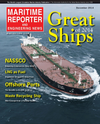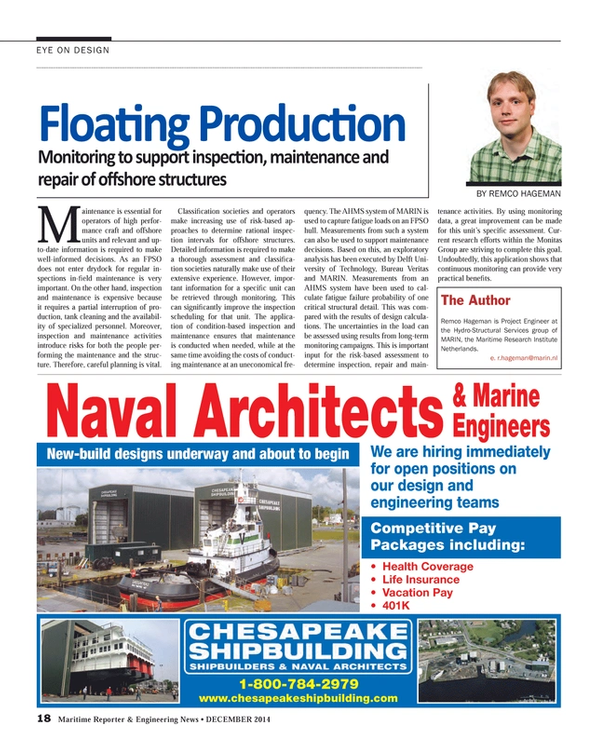
FPSOs Require Special Monitoring to Support IMR
MARIN has used measurements from one of the Advisory Hull Monitoring Systems for FPSOs to improve inspection schedule planning and to support operators in making maintenance decisions.
Maintenance is essential for operators of high performance craft and offshore units and relevant and up-to-date information is required to make well-informed decisions. As an FPSO does not enter drydock for regular inspections in-field maintenance is very important. On the other hand, inspection and maintenance is expensive because it requires a partial interruption of production, tank cleaning and the availability of specialized personnel. Moreover, inspection and maintenance activities introduce risks for both the people performing the maintenance and the structure. Therefore, careful planning is vital.
Classification societies and operators make increasing use of risk-based approaches to determine rational inspection intervals for offshore structures. Detailed information is required to make a thorough assessment and classification societies naturally make use of their extensive experience. However, important information for a specific unit can be retrieved through monitoring. This can significantly improve the inspection scheduling for that unit. The application of condition-based inspection and maintenance ensures that maintenance is conducted when needed, while at the same time avoiding the costs of conducting maintenance at an uneconomical frequency.
The AHMS system of MARIN is used to capture fatigue loads on an FPSO hull. Measurements from such a system can also be used to support maintenance decisions. Based on this, an exploratory analysis has been executed by Delft University of Technology, Bureau Veritas and MARIN. Measurements from an AHMS system have been used to calculate fatigue failure probability of one critical structural detail. This was compared with the results of design calculations. The uncertainties in the load can be assessed using results from long-term monitoring campaigns. This is important input for the risk-based assessment to determine inspection, repair and maintenance activities. By using monitoring data, a great improvement can be made for this unit’s specific assessment. Current research efforts within the Monitas Group are striving to complete this goal. Undoubtedly, this application shows that continuous monitoring can provide very practical benefits.
The Author
Remco Hageman is Project Engineer at the Hydro-Structural Services group of MARIN, the Maritime Research Institute Netherlands.
e. [email protected]
(As published in the December 2014 edition of Maritime Reporter & Engineering News - http://magazines.marinelink.com/Magazines/MaritimeReporter)
Read FPSOs Require Special Monitoring to Support IMR in Pdf, Flash or Html5 edition of December 2014 Maritime Reporter
Other stories from December 2014 issue
Content
- Satellites Reveal Worldwide Ship Traffic Up 300% page: 10
- Bulk Carrier Freight Rates Predicted to Peak in 2016 page: 12
- MLC2006 Impact: 113 Ships Detained page: 13
- Maritime Quarantine & Isolation page: 16
- FPSOs Require Special Monitoring to Support IMR page: 18
- As Interest in LNG Surges, Regulators Struggle to Keep Pace page: 20
- NASSCO: The Face of US Shipbuilding page: 24
- Hempel: Born in Maritime page: 29
- Since 1927, The Damen Way page: 30
- Air Products: Pioneering Gas Processing Solutions page: 32
- Alfa Laval: Keeping it Clean page: 33
- R.W. Fernstrum: Keeping it Cool page: 34
- MAN Diesel & Turbo: Power Play page: 35
- MLS: eLearning Re-thought page: 36
- Great Ships of 2014: Al Kout Environmental, Piracy Protected, Proven page: 40
- Great Ships of 2014: Allseas’ Pieter Schelte page: 42
- Great Ships of 2014: CSCL Globe - world’s largest containership page: 44
- Great Ships of 2014: Harvey Energy page: 45
- Great Ships of 2014: Quantum of the Seas page: 46
- Great Ships of 2014: The Hybrid-Powered Semper Fi page: 47
- Great Ships of 2014: Ceona Amazon page: 48
- Great Ships of 2014: R/V Neil Armstrong - Multifaceted Sea Explorer page: 50
- Great Ships of 2014: Linda Oldendorff page: 51
- Great Ships of 2014: CSAV Tyndall page: 52
- Great Ships of 2014: Top Coral Do Atlantico - A 'Mega' Pipelayer page: 52
- Great Ships of 2014: Linda Oldendorff page: 53
- Great Ships of 2014: Harvest Frost page: 53
- Great Ships of 2014: Gas Star - 84,000 CBM LPG Carrier page: 54
- Great Ships of 2014: M/V Harvest Leader - ECO Class PCTC page: 55
- Lindenau’s Concept: Waste Recycling Ships page: 56
- Great ships of 2014: Siem Moxie page: 57
- Great Ships of 2014: Höegh Jacksonville page: 57
- Are Offshore Ports the Future? page: 58
- Marine Lubricants: New Year, New Emission Rules page: 62
- Phoenix EcoMod 450 Floodlight page: 71
- MES, Viking Yachts Partner for Quiet Performance page: 71
- Air Purifying System for Tug-turned-superyacht page: 71
- Norsafe for Pieter Schelte page: 71
- EnviroLogic: SVGP Compliant Fluids & Cleaners page: 71
- ExxonMobil Debuts Zinc-free Marine Engine Oil page: 71
- Water Reclamation System Delivered to Transocean page: 71
- Ocean Signal Debuts RescueME EPIRB1 page: 71
- NEW EAL from Shell: Naturelle Stern Tube Fluid page: 71
- Inventor. Builder. Entrepreneur. Optimist. Schweitzer page: 86


